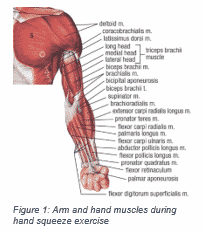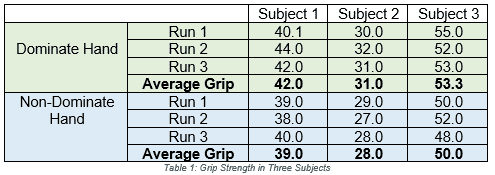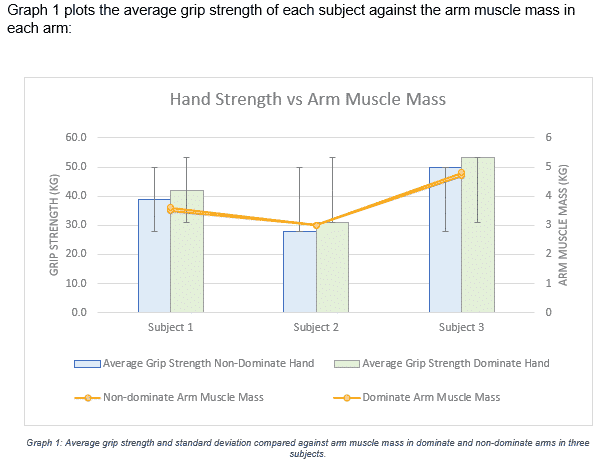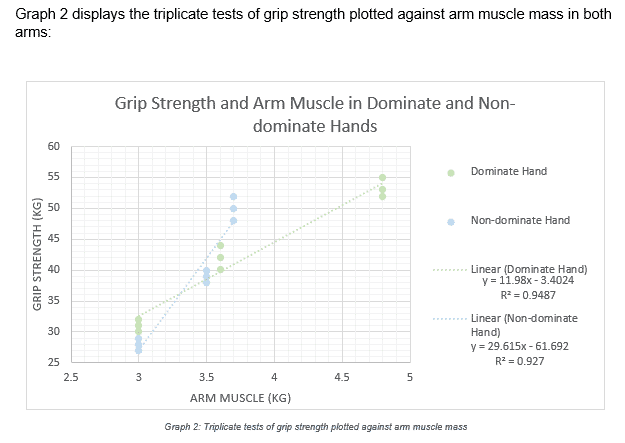Introduction

During a grip motion, the skeletal muscles in the arm and hand are used to generate and maintain the grip (Schoenfeld, 2012). Figure 1 shows the muscles, including the deltoids, triceps, biceps, and palmar muscles, that are involved in controlling movement and strength in the hand.
Motor functions are controlled directly by the CNS and can comprise voluntary and involuntary movements. Previous research indicates a correlation between the contractable muscle available and grip strength. A study published in Experimental Brain Research found that as the amount of contractible muscle decreased in the arm, so did the grip strength of an individual (Ambike et al., 2014).
The muscle fibers contract and relax simultaneously to produce and sustain the movement, including generating grip. Myosin and actin form thick and thin filaments, respectively, which are arranged into hexagonal patterns to form sarcomeres (Sherwood, 2016). Cross-bridges connect thick and thin filaments and allow contraction according to the sliding filament theory.
This theory states that the muscle fiber is activated by an action potential from a motor neuron that stimulates the release of calcium ions; these ions displace troponin on the actin filaments exposing the myosin-binding sites. The actin-binding site on the myosin filament head and the myosin-binding site on the actin filament connect shortening the length of the sarcomere during muscle contraction (Krans, 2010).
This shortening motion is driven by chemical energy stored in the myosin filament head; when activated ADP is released from the head, the motion of the head is driven by stored chemical energy and is halted by the attachment of ATP; this ATP is then converted into ADP with released chemical energy stored in order to perform the next shortening motion (Alila Medical Media, 2016).
This experiment was performed to determine if the arm muscle affected the grip strength of an individual. It was hypothesized that arm muscle is directly proportional to grip strength – as arm muscle mass increases so will grip strength.
Method
Three healthy subjects were tested to determine if hand strength is proportional to the amount of muscle present in the arm. An electronic dynamometer was used by the subjects to determine grip strength. The subject parameters of age and gender were entered into the equipment in line with the manufacturer’s instructions.
Each subject held the dynamometer in their palm with all four fingers wrapped around the lever. The arm of the subject was at the fore of the body with the elbow at a right angle at the torso. Once the timer started the subject squeezed the lever as hard as possible while keeping the rest of the body still, for approximately five seconds. Both the dominant and non-dominate arms of each subject were tested in triplicate.
Once complete, the scales were used to measure the weight of muscle in each arm. The subjects stood with bare feet on a body composition scale until the reading was complete. The muscle weight of each arm was noted.
Results
Table 1 collates the grip strength data of each subject’s dominate and non-dominate hands with average grip strength calculated:

Graph 1 plots the average grip strength of each subject against the arm muscle mass in each arm:

This graph shows a trend indicating that as arm muscle mass increases so does grip. Subject two had the least amount of arm muscle and the lowest grip strength, whereas subject three had both the highest arm muscle mass and grip strength. Additionally, the non-dominate hand had lesser grip strength even if a subject had equal muscle mass in both arms, as seen in subject two.
Graph 2 displays the triplicate tests of grip strength plotted against arm muscle mass in both arms:

The R2 values for dominate and non-dominate hand data both are greater than 0.90. R2 values quantify how well a data set fits the trendline and must be a value between 0 and 1. The closer to 1 the R2 is, the better the selected regression model fits the data trend. Since both sets of data have high R2 values, a positive linear model explains the relationship between muscle mass and grip strength.
The variance R2 values between the non-dominate and dominate hand data sets are not statistically significant and might be attributed to slight variations in the experimental set-up in testing each side.
Discussion
The positive linear relationship between muscle mass and grip strength, as seen by high R2 values in the data set, can be attributed to the structure and function of muscles. Muscles are comprised of myofibrils which have sarcomere functional units. Muscle mass increases are due to the addition of new myofibrils adding to the muscle structure.
When an individual squeezes the hand dynamometer, motor neurons send an impulse, and the sarcomeres contract, through the sliding filament theory, resulting in the grip force. An increased number of sarcomeres present to contract in the arm and hand will generate more force increasing grip strength.
Differences between the performance of grip strength in dominant and non-dominate hands are not affected by muscle mass but rather differences in muscle composition. Studies indicate that dominant arms and hands have an increased presence of motor neurons and fast-twitch muscle fibers, responsible for generating quick, high-force movements (Kawabata, Demura, and Kitabayashi, 2013).
Additionally, motor neurons in dominant muscle structures have a higher firing rate compared to non-dominate arm and hand muscles (Adam, Luca, and Erim, 1998). These compositional differences in the muscles lead to a grip strength differential seen within the experiment.
Conclusion
This experiment sought to determine the relationship between arm muscle mass and grip strength in dominant and non-dominate arms. The results showed a clear positive relationship between muscle mass and grip strength with the dominant hand consistently producing stronger grips than the non-dominate hand.
The mass of muscle influences the grip strength was determined to be due to the number of sarcomeres available to contract to generate force. Dominate grip strength was stronger than non-dominate grip strength due to the increased presence of motor neurons and fast twitched fibers present in the dominant muscle.
The limitations of the study were that the sample size was small and focused on university students – this is not a representative sample of all humans. Additionally, the electronic hand dynamometer and body composition scale had an absolute error range of 50g, which might have influenced results. The findings of this experiment could be strengthened with further research which uses a more substantial, diverse sample.
Reference List
Adam, A., Luca, C.J.D. and Erim, Z. (1998). Hand Dominance and Motor Unit Firing Behavior. Journal of Neurophysiology, [online] 80(3), pp.1373–1382. Available at: https://www.physiology.org/doi/full/10.1152/jn.1998.80.3.1373?url_ver=Z39.88-2003&rfr_id=ori:rid:crossref.org&rfr_dat=cr_pub%3dpubmed [Accessed 23 Nov. 2019].
Alila Medical Media (2016). Muscle Contraction – Cross Bridge Cycle, Animation. YouTube. Available at: https://www.youtube.com/watch?v=BVcgO4p88AA [Accessed 25 May 2019].
Ambike, S., Paclet, F., Zatsiorsky, V.M. and Latash, M.L. (2014). Factors Affecting Grip Force: Anatomy, Mechanics, and Referent Configurations. Experimental Brain Research, [online] 232(4), pp.1219–1231. Available at: https://www.ncbi.nlm.nih.gov/pmc/articles/PMC4013148/ [Accessed 22 Nov. 2019].
Kawabata, H., Demura, S. and Kitabayashi, T. (2013). Superior pinch strength in the dominant versus nondominant hand. Sport Sciences for Health, 9(1), pp.7–11. Available at: https://link.springer.com/article/10.1007%2Fs11332-013-0138-9 [Accessed 23 Nov. 2019].
Krans, J.L. (2010). Sliding Filament Theory, Sarcomere, Muscle Contraction, Myosin. [online] Scitable. Available at: https://www.nature.com/scitable/topicpage/the-sliding-filament-theory-of-muscle-contraction-14567666/ [Accessed 22 Nov. 2019].
Schoenfeld, M. (2012). The 3 Types of Grip and the 8 Ways to Train Them. Breaking Muscle. Available at: https://breakingmuscle.com/fitness/the-3-types-of-grip-and-the-8-ways-to-train-them [Accessed 26 Nov. 2019].
Sherwood, L. (2016). Human Physiology: from Cells to Systems. 9th ed. Boston: Cengage Learning, pp.251–275.
